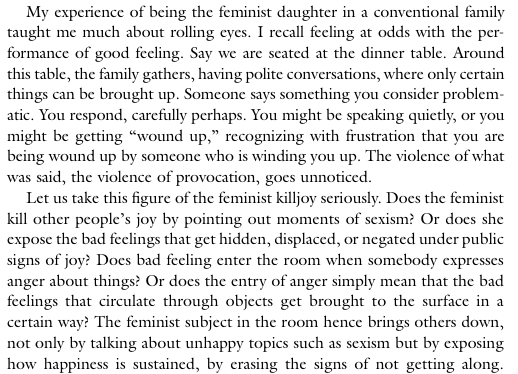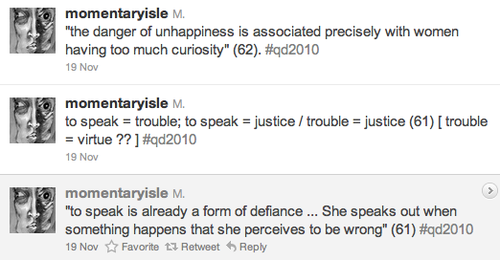For class discussion of the Introduction and Chapter 1 of The Promise of Happiness.
Who is Sara Ahmed? Visit her faculty page at Goldsmiths, University of London. You can read her research profile, research interests and publications. Here’s a blurb about The Promise of Happiness:
The Promise of Happiness (2010) considers how we are directed toward certain objects by the promise of happiness, such that we “happen” upon those things that are already attributed as happiness causes. In this book, I explore how the freedom to pursue “whatever” makes us happy is directive: we are free to pursue this “whatever” on condition that it causes happiness, which as a condition involves an implicit demand that we make certain choices. Drawing on feminist, queer and anti-racist “unhappy archives,” as archives that are assembled out of the struggle against happiness, the book considers happiness by taking up those who enter its history as “wretches”, “killjoys” and “affect aliens.” It analyses how one history of happiness is the history of the removal of the hap from happiness, and calls not only for “the freedom to be unhappy,” but for a politics that puts the “hap” back into happiness.
Sara Ahmed
Now, onto The Promise of Happiness. There are many different ways to approach the feminist killjoy (and how it connects with our discussions this semester). Here are just a few:
Shift attention from “what is happiness?” to “What does happiness do?”
THE HAPPY HOUSEWIFE: How does the “happy housewife” function on mommy blogs? Check out these google searches: mommy blogs happy and happy housewife blogs
Here’s what Ahmed has to say about this type of blogging:
On the internet, we witness a new generation of bloggers who take on this identity of ‘the happy housewife.’ These bloggers use the opportunity of the public space generated by new technologies to make public their claim of happiness (53).
Sara Ahmed
Ahmed doesn’t devote much time to social media and happiness. Does the myth of this “happy housewife” get reinforced on i or other forms of social media? If so, how?
BEING HAPPY IN THE RIGHT WAY:
Key claim: “the very hope for happiness means we get directed in specific ways, as happiness is assumed to follow from some life choices and not others” (54). What life choices are supposed to lead to happiness and which are not? Who gets to decide what leads to happiness and how are those decisions made?
The face of happiness, at least in this description, looks rather like the face of privilege. Rather than assuming happiness is simply found in “happy persons,” we can consider how claims to happiness make certain forms of personhood valuable (11).
Sara Ahmed
Promoting happiness promotes certain ways of living (over others) and certain types of families (11).
“Ideas of happiness involve social as well as moral distinctions insofar as they rest on ideas of who is worthy as well as capable of being happy ‘in the right way'” (13). What conclusions can we draw about what happiness is from this commercial (check out the comments on youtube too)? Is this happiness in the “right way”?
SOME GOALS FOR AHMED:
- Suspending belief that happiness is a good thing. “This book proceeds by suspending belief that happiness is a good thing [note: not by rejecting but suspending belief]. In this mode of suspension, we can consider not only what makes happiness good but how happiness participates in making things good….My task is to think about how feelings make some things and not others good” (13).
- Tracking the word happiness: “In order to consider how happiness makes things good, I track the word happiness, asking what histories are evoked by the mobility of this word. I follow the word happiness around” (14).
- Exploring the happiness archive: “a set of ideas, thoughts, narratives, images, impressions about what is happiness” (15).
- Asking questions about happiness and its history/histories: “what does it mean to think of happiness as having a history? How or why should we write such a history? Who or what would belong in this history” (16)?
- Rewriting history from the point of view of the wretch: “I thus offer an alternative history of happiness not simply by offering different readings of its intellectual history but by considering those who are banished from it, or who enter this history only as troublemakers, dissenters, killers of joy” (17).
- Giving the killjoy a voice: “This book is an attempt to give the killjoy back [their] voice and to speak from recognition of how it feels to inhabit that place” (20).
- Not spreading unhappiness but making room for other ways of living/imaging life: “I know that I risk overemphasizing the problems with happiness by presenting happiness as a problem. It is a risk that I am willing to take. If this book kills joy, then it does what it says we should do. To kill joy…is to open a life, to make room for life, to make room for possibility, for chance. My aim in this book is to make room” (20).
TROUBLEMAKERS:
Going along with this duty [to make parents/others happy] can mean simply approximating the signs of being happy–passing as happy–in order to keep things in the right place. Feminist genealogies can be described as genealogies of women who not only do not place their hopes for happiness in the right things but who speak out about their unhappiness with the very obligation to be made happy by such things. The history of feminism is thus a history of making trouble…by refusing to follow other people’s goods, or by refusing to make others happy (60).
Sara Ahmed
Happiness shapes what coheres as a world (2).
AT THE DINNER TABLE:
While I am not sure that we would consider Debbie Downer a feminist killjoy, Ahmed’s discussion about the polite politics at the dinner table reminded me of the SNL skit (with Rachel Dratch) in which Debbie Downer “ruins” Thanksgiving dinner for her family. What isn’t “right”/goes wrong in this family dinner? Does Debbie Downer simply kill the joy of the others or does she read that joy from the perspective of the “wretched”?
Here is a (just) slightly different version of what Ahmed writes on page 61:
What do we make of this clip? How does humor function in this skit? What kind of killjoy is Debbie Downer? Is she a feminist one–or some other type? Can we envision her killing of joy as ever being productive or leading to transformation? Or is it (too) easy to dismiss? How can we read this second Thanksgiving scene beside/against/through the first one (Publix commercial)?
Here’s another humorous clip that envisions the woman (is she a feminist killjoy?) killing the joy at a dinner party by speaking her mind and thinking too much:
Is she a feminist killjoy? Consider the following passages in relation to the video clip:
We might explore how imagination [being curious and thinking critically] is what allows women to be liberated from happiness and the narrowness of its horizons (62).
Sara Ahmed
But if we do not operate in this economy–that is, if we do not assume that happiness is what is good–then we can read the link between female imagination and unhappiness differently. We might explore how imagination is what allows women to be liberated from happiness and the narrowness of horizons. We might want the girls to read the books that enable them to be overwhelmed with grief (62).
We can talk about being angry black women or feminist killjoys; we can claim those figures back; we can talk about those conversations we have had at dinner tables or in seminars or meetings; we can laugh in recognition of the familiarity of inhabiting that place. There is solidarity in recognizing our alienation from happiness, even if we do not inhabit the same place (as we do not). There can even be joy in killing joy. And kill joy, we must and we do (87).
Sara Ahmed
FYI: I have written about these ideas in several different blog entries. Check them out:

